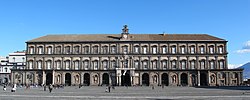
Back القصر الملكي في نابولي Arabic Каралеўскі палац у Неапалі Byelorussian Кралски дворец (Неапол) Bulgarian Palau Reial de Nàpols Catalan Královský palác v Neapoli Czech Palazzo Reale (Neapel) German Βασιλικό Παλάτι της Νάπολης Greek Palacio Real de Nápoles Spanish Napoliko Palazzo Reale Basque Palais royal de Naples French
| Royal Palace of Naples | |
|---|---|
| |
 Royal Palace façade | |
 | |
| General information | |
| Type | Palace |
| Architectural style | Italian Baroque, Neo-Classical |
| Location | Naples, Italy |
| Address | Piazza del Plebiscito 1 |
| Coordinates | 40°50′10″N 14°14′59″E / 40.8362°N 14.2496°E |
| Website | |
| palazzorealedinapoli | |
Invalid designation | |
| Official name | Palazzo Reale di Napoli |
| Type | Non-movable |
| Criteria | Monument |
The Royal Palace of Naples (Italian: Palazzo Reale di Napoli) is a historic building located in Piazza del Plebiscito, in the historic center of Naples, Italy. Although the main entrance is located in this square, there are other accesses to the complex, which also includes the gardens and the Teatro di San Carlo, from the Piazza Trieste e Trento, Piazza del Municipio and Via Acton.

The palace was built from 1600 onwards by the architect Domenico Fontana as the residence of the Spanish viceroys, and in the mid-17th century Francesco Antonio Picchiatti made numerous improvements and interventions, such as the staircase and the chapel. Charles of Bourbon made it, from 1734, the main residence of the Bourbons of Naples for more than a hundred years, first as kings of Naples and Sicily (1734-1816) and later as kings of the Two Sicilies (1816-1861). It was also the residence of Joseph Bonaparte and Joachim Murat during French rule (1806-1815), under which extensive redecorations were carried out.
The Bourbons made important and constant modifications to the interiors of the palace, relying on great artists such as Francesco de Mura or Francesco Solimena. However, after the fire of 1837, the palace had to be almost completely rebuilt by Gaetano Genovese, who finished the unfinished wings and gave a homogeneous appearance to the entire complex.
After the Italian unification (1861) it passed into the hands of the Savoy,[1] until Victor Emmanuel III ceded it to the state in 1919. From the late 19th cenury, the western half of the palace was opened to the public as a museum of the Royal Apartment, and in 1924 its eastern half became the home of the National Library, uses that continue today.
- ^ Porzio 2014, p. 69
© MMXXIII Rich X Search. We shall prevail. All rights reserved. Rich X Search